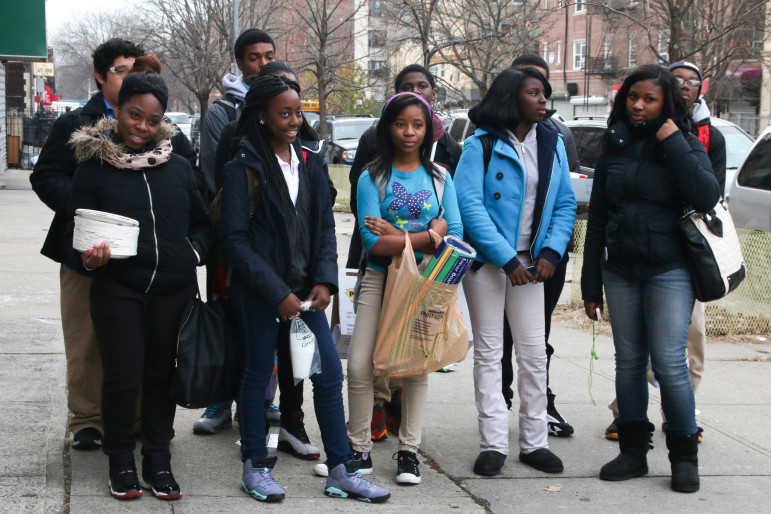
Pilar Belendez-Desha
YO S.O.S. — or Youth Organizing to Save Our Streets — begun in 2011, trains teens to be leaders and organizers in their neighborhood and mentors them on how to reverse trends in gun violence.
NEW YORK — The step at the bottom of the ladder was titled calm and the step at the top was titled — in big red letters — RAGE.
“How can you go from calm to rage?” said Heather Day. “We’re going to think at each level how you’re feeling.”
“Peaceful,” a young woman started off the conversation.
 “Chill,” said another.
“Chill,” said another.
Day took notes at each step and etched her red pen up the ladder as emotions intensified.
“It’d start to get weird,” said a young man.
“Weird? Why weird?” replied Day.
“Cuz, I’m used to crazy things happening.”
“I don’t like people screaming at me,” one youth said.
The group went on like this for 45 minutes on a Tuesday in December. Twenty-two young people from the Crown Heights area were at a biweekly after-school program that’s part of a growing anti-gun violence movement called Save Our Streets.
The youth version of the program is called YO S.O.S. — or Youth Organizing to Save Our Streets. Begun in 2011, it trains teens to be leaders and organizers in their neighborhood and mentors them on how to reverse trends in gun violence.
They sat in a circle at Great Restoration Baptist Church. Heather Day, associate director of youth and community programs at Crown Heights Mediation Center, asked the teens to imagine a normal situation that would have the potential to spin out of control — into rage.
To illustrate this, she drew a stepladder on a large white piece of paper and pointed to the bottom of the ladder, asking what was happening in their lives when they felt calm. The session resembled a cognitive behavioral group therapy session aimed at changing the negative thought patterns youth have.
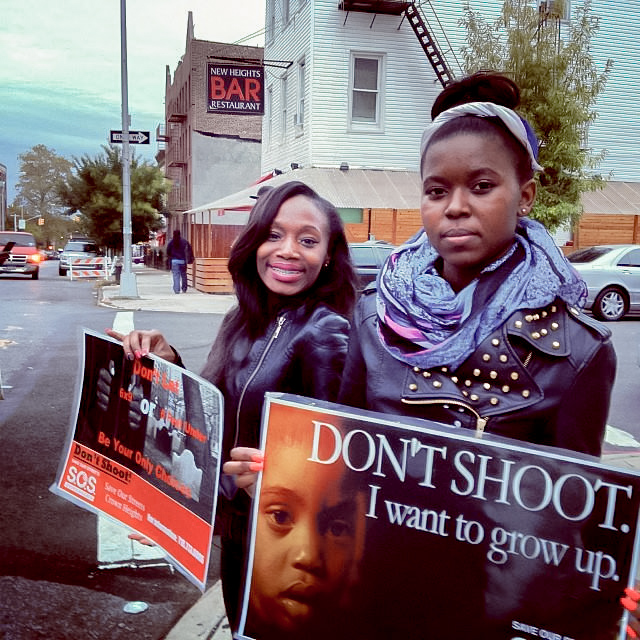
Crown Heights Mediation Center
YO S.O.S. members Asher and Tamia at a shooting response on St. Marks Avenue and Schenectady after a fatal shooting in Oct 2013.
What they think can affect what they feel, and what they feel can turn to actions. Day’s goal that Tuesday, she said later, was to get them to recognize that.
“I start to feel … hot. My hands start to shake,” another youth chimed in.
“What’s the next level?” said Day, her pen jumping up the ladder.
“If I get really mad, I start to laugh.”
Eventually the group decided many of them had been in volatile situations in the past where they could have easily gotten upset and angry, but they didn’t. Day told them de-escalating their feelings this way to avoid rage can be done with practice.
She assigned the teens work throughout the week. Topping the list was to practice taking note of their negative thoughts and trying to regulate high emotions in what she called “triggering situations” — a moment of conflict that can spiral out of control.
“You can use your muscles to get you to 100 really quick,” she said. “Or you can use your muscles to calm yourself down. It takes practice.”
The Save Our Streets outreach team identifies people most likely to be involved in gun violence within a specific 40 square-block radius in Crown Heights. The team has four full-time outreach workers and four part-time violence interrupters. In the summer of 2014, S.O.S. opened a second office in Bedford-Stuyvesant to reduce shootings and killings in a neighboring area as well.
Each outreach worker recruits and enrolls up to 15 people who are at the highest risk for involvement in gun violence and acts as a peer counselor. S.O.S. is a replication of the Cure Violence program in Chicago — formerly known as Ceasefire, which started this kind of gun violence prevention work, experts said.
YO S.O.S. participants are often not the highest-risk individuals, but have grown up surrounded by community violence and express an interest in being the ones to make a positive difference, organizers said.
Street violence at point-blank range
One young anti-gun violence messenger is Cadell Smith, 16, one of Heather Day’s students. He joined in 2014 when two of his classmates recommended the program. He recalled an afternoon when he and his buddy were walking down the street in Crown Heights and saw someone run up to a young man and shoot him — point blank.
“It was just so shocking,” he said. “It was pretty scary.”
“He froze,” Smith said of his friend. “We both froze, actually.”
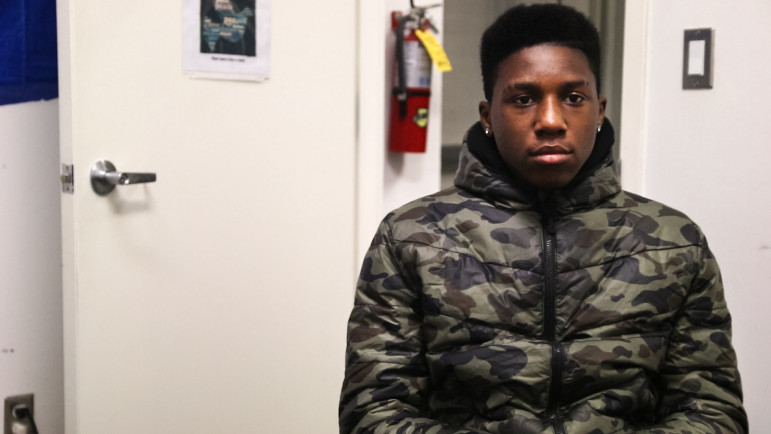
Pilar Belendez-Desha
Cadell Smith, 16, joined YO S.O.S. in 2014 when two of his classmates recommended the program. Smith witnessed a shooting in Crown Heights and now leads focus groups at his school to learn more about perceptions of gun violence.
Twice a week, he works through his experiences with several dozen other teenagers and learns techniques to cope with what he witnessed. Some youth join the program to gain community service experience. Others might have an uncle in prison for a shooting, a cousin or close friend in a gang and they worry about that person’s safety.
Smith is soft-spoken and respected by his mentors and peers; he is one of the older students of the group. He has a hard time talking about what he saw but says he has found new ways to process it. He credits the organization with helping him deal with his violent experiences.
“It makes me think about the bigger picture,” said Smith. “I hear about shootings all the time, shootings in my neighborhood. It was sad but at the same time I was just so numb to it. I didn’t really think about how it affected the families. It didn’t really matter to me before my YO S.O.S. training.”
Smith said with his violence de-escalation training he can see when a situation is getting out of hand and take time to process and evaluate it. He said he takes his lessons to the neighborhood. He and other members have decided to form focus groups with students in their own schools. This allows them to learn more about local perceptions of safety and experiences with violence in and around their schools, he said.
One of the aims of the youth program, according to Day, is to encourage youth to spread the anti-gun violence message peer-to-peer. Day says youth are credible to other youth because teens want to hear from their peers and trust what they have to say. It creates a ripple effect in the neighborhood if one youth speaks out against gun violence. They pay more attention if it is coming from someone their own age, and not from an adult telling them what to do.
This anti-gun violence leadership program is seen by council member Laurie Cumbo as essential in a community that has a history of retaliatory gun violence. In the first two months of 2015 New York City saw shootings incidences go up 25 percent, according to Police Commissioner William Bratton.
“The reduction of crime in any given neighborhood is a shared responsibility between area residents, local law enforcement officers, and community organizations,” she said in a response by email. “In Crown Heights, we are truly fortunate to have the Crown Heights Mediation Center, Youth Organizing to Save Our Streets, Deputy Inspector Eddie Lott and the incredible officers of the 77th Precinct.”
‘Don’t shoot, I want to grow up’
The Crown Heights Community Mediation Center first opened in 1998 as a response to the riots that erupted between Hasidic Jews and blacks in 1991. Center director Amy Ellenbogen said she wanted to focus on making the neighborhood safer and healthier for all residents.
In 2005, after a series of local shootings, the center began to focus on eradicating gun violence through community involvement. In 2009 it received federal funding to replicate Cure Violence.
The U.S Department of Justice found that Cure Violence eliminated retaliatory murders and decreased shooting incidents by treating gun violence as a communicable disease.
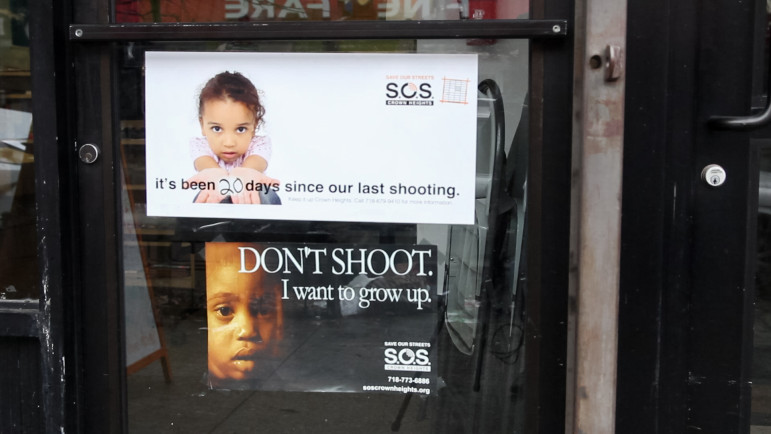
Pilar Belendez-Desha
The Crown Heights Mediation Center brings awareness to gun violence by using public education slogans featuring images of doe-eyed toddlers, and “It’s been X amount of days since our last shooting incident.”
As if it’s publicizing disease eradication, the center uses public education slogans that feature pictures of doe-eyed toddlers, saying: “Don’t shoot, I want to grow up.”
The S.O.S. staff has worked with local businesses and organizations to display public education material in their storefront windows. The signs read: “It’s been X amount of days since our last shooting incident.”
These public education campaigns and outreach efforts work, according to the S.O.S. staff.
“You could talk about a Patient Zero with Ebola,” Day said. “You try to track where did that person go, who did they have interactions with and work with those people. The same [idea] sort of goes for how we respond to violence.”
They look at who is exposed to violence directly or indirectly and then try to stop violence from spreading, she said.
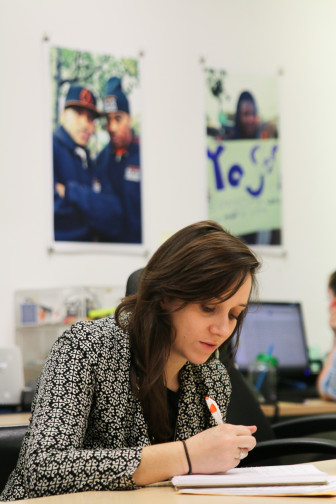
Pilar Belendez-Desha
Marlies Talay, operations manager and neighbor services coordinator for the Mediation Center.
Every weekday around lunchtime, Marlies Talay, operations manager and neighbor services coordinator for the center, walks the 40 square-block radius on a mission to update the statistics handwritten on Save Our Streets posters.
Today Talay erases the number 93 and writes in 94. The updated sign reads: “It’s been 94 days since our last shooting.”
“I’m always happy when the numbers are increasing, of course,” Talay said. “And I hate the idea of people, especially children, seeing the number zero on the signs.”
Research sponsored by The Center For Court Innovation shows monthly gun violence in Crown Heights decreased 6 percent, while surrounding neighborhoods — East Flatbush, Brownsville, Bedford-Stuyvesant — saw an 18 to 28 percent increase in shooting incidents. The decrease could be coincidental, of course, and not directly attributable to S.O.S.’s work. But researchers concluded that the decrease may in fact be attributed to the Mediation Center’s anti-gun violence programs.
Day says there were no other violence prevention interventions in Crown Heights when the research was being conducted.
S.O.S. is one of 10 New York City anti-gun violence pilot programs modeled after the Cure Violence program. City Hall has paid attention. Mayor Bill de Blasio allocated $12.7 million last August to fund similar programs in 18 other at-risk neighborhoods throughout the city.
Day said she hopes that the YO S.O.S. programs will be duplicated one day as well. Currently, she said, YO S.O.S. is the only one of its kind in the country.
This isn’t a movie, it’s real life
David Gaskin, S.O.S. outreach worker supervisor, leads a team of seven S.O.S. members who monitor the streets from 1 p.m. to midnight, mediating any unrest. They locate the neighborhood’s high-risk individuals and refer them to the services they need, such as mental health or legal aid.
Like all members of the team, he is known to the neighborhood as a credible messenger because he was born and raised there. He joined S.O.S. in July 2014. He says people don’t realize that seeing an act of violence on a movie screen or on television is different from witnessing it in person.
“It can create trauma — just seeing a person get shot or seeing a person lose their life,” Gaskin said. “To see it in real life is really shocking.”
When a young person experiences or witnesses an act of violence, experts say, it can lead to post-traumatic stress disorder, or PTSD. Young people don’t even have to witness violence directly, they just have to hear about it or see on the news that violence is prevalent in their neighborhood. Even this second-hand contact threatens perceptions of safety and makes children more likely to protect themselves in bold ways — such as carrying a gun.
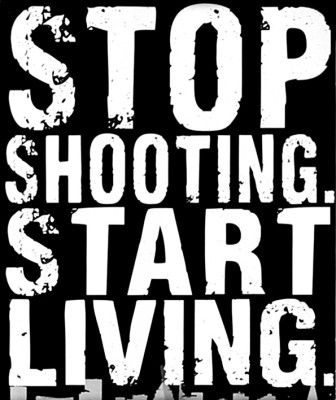 In a federally funded study led by the Grady Trauma Project, researchers found inner-city residents showed higher rates of PTSD than even veterans who had served in Vietnam, Afghanistan and Iraq. PTSD affects African Americans and Latino populations living in urban areas the most, the study said. Extreme amounts of trauma and exposure will most likely occur during one’s youth.
In a federally funded study led by the Grady Trauma Project, researchers found inner-city residents showed higher rates of PTSD than even veterans who had served in Vietnam, Afghanistan and Iraq. PTSD affects African Americans and Latino populations living in urban areas the most, the study said. Extreme amounts of trauma and exposure will most likely occur during one’s youth.
Gaskin’s S.O.S. team wears uniforms, including black hoodies. A large logo on the back of their sweatshirts implores neighborhood residents to “stop shooting and start living.”
When they walk together at night, sometimes residents are hesitant to engage with them at first. But, he says, when a young person finds out Gaskin is trying to spread an anti-gun violence message, there is usually a sigh of relief. Part of his mission is to connect with teenagers at local schools.
“If S.O.S. wasn’t in the neighborhood, who is going to spread these messages?” he asked.
One-stop shopping for a community’s needs
Talay finishes changing the numbers on the neighborhood posters and returns to the office, where it becomes clear the center will help pretty much any neighborhood resident with any of their problems.
If an elder walks in befuddled by a cell phone that won’t turn on, Talay will cheerfully troubleshoot. Perhaps a homeless man has his SNAP benefits cut off. Talay will call the proper officials, set up a hearing, then walk around the neighborhood to find and inform him of the hearing.
If she can’t help she’ll put them in touch with a lawyer from the Legal Aid Society. Within 72 hours of a neighborhood shooting, she contacts locals and helps organize a rally at the site with the intention of preventing further violence.
Lisa McKay walks in and casually hands Talay a resume asking her to review it.
“I applied for a part-time job at Columbia Hospital and I didn’t get it,” McKay said. “I was a bit upset.”
Talay shifts gears and reformats her resume.
McKay looks around the office and notices the bustle of YO S.O.S. coming in.
“What is it you all do here in this office?” she said.
Talay doesn’t miss a beat and optimistically tells McKay about the program. She has given a version of this five-minute speech three times before 3 p.m. McKay quickly asks how her teenager can become involved.
“Unfortunately the youth program’s slots are completely full this year,” Talay responds.
McKay, who thought her son would be a perfect fit for the program, is disappointed. Amid the bustle, she returns to her resume.
But he's welcome to apply next year, Talay adds.